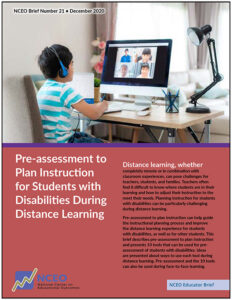 NCEO recently published Pre-assessment to Plan Instruction for Students with Disabilities During Distance Learning (NCEO Brief #21). This Brief describes using pre-assessment to plan instruction for students with disabilities, and presents 10 tools that can be used particularly during distance learning. Pre-assessment to plan instruction can help guide the instructional planning process and focus on the specific content to be taught in a unit or sequence of lessons.
NCEO recently published Pre-assessment to Plan Instruction for Students with Disabilities During Distance Learning (NCEO Brief #21). This Brief describes using pre-assessment to plan instruction for students with disabilities, and presents 10 tools that can be used particularly during distance learning. Pre-assessment to plan instruction can help guide the instructional planning process and focus on the specific content to be taught in a unit or sequence of lessons.
Pre-assessment to plan instruction (hereafter, “pre-assessment”) is a kind of formative assessment that occurs before instruction to support instructional planning and inform students about upcoming learning. Teachers can use pre-assessments to help guide instructional planning, and students can use pre-assessments as advance organizers and to focus their attention on what they already know about upcoming learning targets. When using pre-assessments, teachers can use available online apps and other approaches that they know engage students with disabilities who are learning in a virtual environment. The Brief includes examples of how accessibility needs can be addressed when using the pre-assessment tools.
This Brief presents ten tools that can be used in pre-assessment:
- Oral questioning/introductory discussion
- Brainstorming session
- Small-group task
- Journal or quick-write prompts
- Whiteboard prompts
- Single multiple-choice question with distractors based on common misconceptions
- Venn diagram
- Concept map
- K-W-L chart
- Pre-assessment quiz
The information in this Brief can also be used when instruction is fully in-person, as well as during hybrid and blended learning.
You may also want to check out a companion Brief to this one. Five Formative Assessment Strategies to Improve Distance Learning Outcomes for Students with Disabilities describes how formative assessment can be used during instruction.
